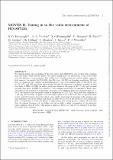Files in this item
MOVES - II. Tuning in to the radio environment of HD189733b
Item metadata
| dc.contributor.author | Kavanagh, R. D. | |
| dc.contributor.author | Vidotto, A. A. | |
| dc.contributor.author | Ó. Fionnagáin, D. | |
| dc.contributor.author | Bourrier, V. | |
| dc.contributor.author | Fares, R. | |
| dc.contributor.author | Jardine, M. | |
| dc.contributor.author | Helling, Ch | |
| dc.contributor.author | Moutou, C. | |
| dc.contributor.author | Llama, J. | |
| dc.contributor.author | Wheatley, P. J. | |
| dc.date.accessioned | 2019-03-26T12:30:09Z | |
| dc.date.available | 2019-03-26T12:30:09Z | |
| dc.date.issued | 2019-06 | |
| dc.identifier | 258319462 | |
| dc.identifier | 6276446e-4e09-4112-a976-8a98733ae1b3 | |
| dc.identifier | 85064112096 | |
| dc.identifier | 000474880400007 | |
| dc.identifier.citation | Kavanagh , R D , Vidotto , A A , Ó. Fionnagáin , D , Bourrier , V , Fares , R , Jardine , M , Helling , C , Moutou , C , Llama , J & Wheatley , P J 2019 , ' MOVES - II. Tuning in to the radio environment of HD189733b ' , Monthly Notices of the Royal Astronomical Society , vol. 485 , no. 4 , pp. 4529–4538 . https://doi.org/10.1093/mnras/stz655 | en |
| dc.identifier.issn | 0035-8711 | |
| dc.identifier.other | BibCode: 2019MNRAS.tmp..632K | |
| dc.identifier.other | ORCID: /0000-0002-1466-5236/work/57821892 | |
| dc.identifier.uri | https://hdl.handle.net/10023/17373 | |
| dc.description.abstract | We present stellar wind modelling of the hot Jupiter host HD189733, and predict radio emission from the stellar wind and the planet, the latter arising from the interaction of the stellar wind with the planetary magnetosphere. Our stellar wind models incorporate surface stellar magnetic field maps at the epochs 2013 June/July, 2014 September, and 2015 July as boundary conditions. We find that the mass-loss rate, angular momentum loss rate, and open magnetic flux of HD189733 vary by 9 per cent, 40 per cent, and 19 per cent over these three epochs. Solving the equations of radiative transfer, we find that from 10 MHz–100 GHz the stellar wind emits fluxes in the range of 10−3–5 μJy, and becomes optically thin above 10 GHz. Our planetary radio emission model uses the radiometric Bode’s law, and neglects the presence of a planetary atmosphere. For assumed planetary magnetic fields of 1–10 G, we estimate that the planet emits at frequencies of 2–25 MHz, with peak flux densities of 102 mJy. We find that the planet orbits through regions of the stellar wind that are optically thick to the emitted frequency from the planet. As a result, unattenuated planetary radio emission can only propagate out of the system and reach the observer for 67 per cent of the orbit for a 10 G planetary field, corresponding to when the planet is approaching and leaving primary transit. We also find that the plasma frequency of the stellar wind is too high to allow propagation of the planetary radio emission below 21 MHz. This means a planetary field of at least 8 G is required to produce detectable radio emission. | |
| dc.format.extent | 10 | |
| dc.format.extent | 17537579 | |
| dc.language.iso | eng | |
| dc.relation.ispartof | Monthly Notices of the Royal Astronomical Society | en |
| dc.subject | MHD | en |
| dc.subject | Stars: individual (HD189733) | en |
| dc.subject | Stars: low-mass | en |
| dc.subject | Stars: planetary systems | en |
| dc.subject | Stars: winds, outflows | en |
| dc.subject | QB Astronomy | en |
| dc.subject | QC Physics | en |
| dc.subject | Astronomy and Astrophysics | en |
| dc.subject | Space and Planetary Science | en |
| dc.subject | NDAS | en |
| dc.subject.lcc | QB | en |
| dc.subject.lcc | QC | en |
| dc.title | MOVES - II. Tuning in to the radio environment of HD189733b | en |
| dc.type | Journal article | en |
| dc.contributor.sponsor | Science & Technology Facilities Council | en |
| dc.contributor.sponsor | Science & Technology Facilities Council | en |
| dc.contributor.institution | University of St Andrews. School of Physics and Astronomy | en |
| dc.identifier.doi | https://doi.org/10.1093/mnras/stz655 | |
| dc.description.status | Peer reviewed | en |
| dc.identifier.url | http://adsabs.harvard.edu/abs/2019MNRAS.tmp..632K | en |
| dc.identifier.grantnumber | ST/R00824/1 | en |
| dc.identifier.grantnumber | ST/M001296/1 | en |
This item appears in the following Collection(s)
Items in the St Andrews Research Repository are protected by copyright, with all rights reserved, unless otherwise indicated.

